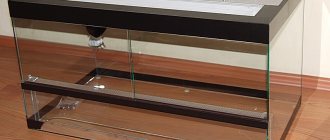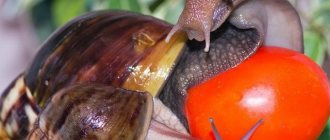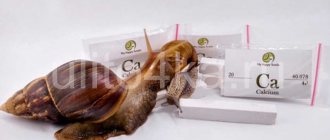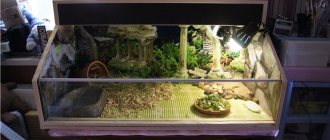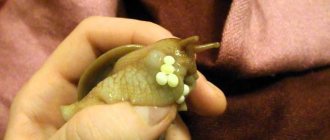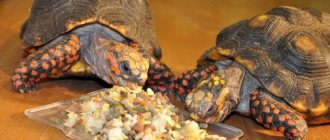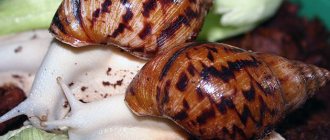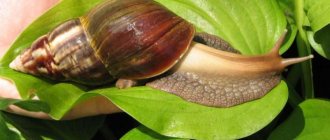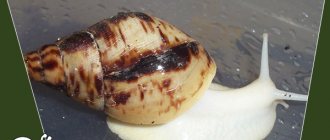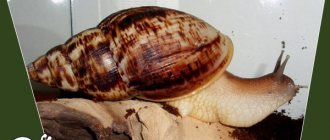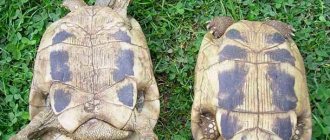Achatina are truly unique and interesting creatures. This type of snail is gaining more and more popularity as pets every year. However, before you become the owner of these exotic muskies for the first time, the issue of keeping them at home should be carefully studied. In addition to the specifics of care, there are certain nuances of maintenance, for example, a terrarium for snails.
Achatina requires no draft
How to choose soil for a terrarium
African Achatina is one of the largest land mollusks on the planet.
This is the kind of snail that can be placed at home as a family pet. Many owners of such a miracle of nature are convinced that they are very sociable and recognize the owner, do not take refuge in the house when he appears and allow him to stroke his body. It is better to place the pet in a specialized terrarium for Achatina with a perforated lid for air circulation. Moss and coconut substrate are suitable as soil, which should be moistened daily. Snails need cleanliness for normal existence, so the soil should be cleaned at least once a week, and the entire house should be cleaned once every three months.
African Achatina is one of the largest land mollusks on the planet
They do not need additional lighting sources in the terrarium for Achatina snails; snails are active mainly at night, and usually sleep throughout the day, buried in the ground. The optimal temperature range is between 22–28 °C. It is better to protect the terrarium from direct rays of the sun, as well as from a room battery.
The main aspect in the design of a terrarium for land mollusks is the soil. It has many meanings
- the snail sleeps in the ground, lays eggs, and looks for food;
- absorbs and accumulates moisture, helps maintain constant humidity in the terrarium;
- softens the fall of the snail, preventing serious injuries;
- Seeds and living plants are planted in the soil.
The soil should be moist, loose and safe (no fertilizers or microbes). To keep the African snail, use coconut substrate, peat or washed soil from the forest. Replacing the soil in the terrarium should be quick and easy.
READ How to sew or knit clothes for cats with your own hands
To do this, cut off the bottom of a plastic bag suitable for the size of the bottom of your terrarium and pour soil into it. Thus, to replace it, just pull the edges of the bag. The bag is masked with driftwood, moss or dry leaves.
Coconut soil - sold in dry briquettes, which, after soaking in water, turns into soil. Coconut substrate is ideal for keeping the Achatina snail. It does not stain the walls of the terrarium, retains moisture for a long time, and is not susceptible to the formation of mold and mildew. Coconut soil is safe for snails, but it is still better to place food on it. Serve food in a feeder or on lettuce leaves.
Many snail breeders keep African snails in regular soil from the forest or flower shop. But here you should definitely wash the soil with boiling water or fry it in the oven. The soil retains moisture well. Moss and dry leaves are placed on top of it. Seeds and living plants are planted in the soil, which not only decorate the interior of the terrarium, but also serve as additional food for the mollusk.
Sphagnum moss - sold in pet stores, retains moisture well and serves as a living barometer in a terrarium. If the sphagnum dries out, it means the terrarium is not humid enough; if it’s green, then everything is fine. Moss does not need to be changed as often as other substrates and it looks beautiful in any terrarium. However, it should not be used as soil for small Achatina snails.
Sand – keepers have an ambiguous attitude towards this type of soil. Some consider sand to be the natural habitat for African mollusks. Others are categorically against it. Considering it unacceptable, since sand does not hold moisture, sticks to the body and shell of the mollusk, and scratches the glass of the terrarium. It clogs the snail's digestive system, leading to its death.
Sawdust, as soil, also causes quite a bit of controversy about whether it can be used as soil for snails. Sawdust does not absorb water well, as a result of which it quickly sticks together and rots. They also often injure the delicate body of Achatina. If you keep an African mollusk in sawdust, a white coating forms on its shell, which cannot be washed off.
Stones and gravel are strictly prohibited for keeping Achatina. Stones do not absorb water; a snail will not be able to burrow into them. And the worst thing is that the mollusk shell easily breaks when falling from the terrarium lid onto the gravel.
High-quality bedding is a prerequisite for proper maintenance of Achatina in a seine. Needles, sawdust or sand are categorically unsuitable as soil. Achatina has a very delicate body, and soil sticking to it can harm the snail. Ordinary soil is suitable as a soil, but it must be well processed before placing it in a container.
- Thoroughly clear the soil of plants and roots.
- Fry the soil in the oven for 25-30 minutes at the highest temperature. This will get rid of harmful microorganisms that are found in abundance in street soil and can harm Achatina.
READ Soft bedding for a cat with your own hands. DIY cat bed: how to make
Decorative elements
When creating a favorable environment for the inhabitants of an aquarium or terrarium, you can add particles of living nature to it. Certain types of living plants will not only look harmonious in an aquarium with snails, but also maintain the necessary microclimate in it .
Don't forget to place decorative elements
These include:
- fern;
- moss;
- ivy.
Given the flexibility of the latter plant, it is ideal for a small terrarium. And also such types of additional decor as fragments of pottery, unusual-looking sea stones, and mollusk shells will organically fit into this landscape.
Manufacturing materials
The most common options are.
- Glass. There are two options here: organic or mineral.
- Plexiglass.
- Plastic.
Each of the above materials has certain characteristics, but all of them are suitable for constructing a terrarium. Plexiglas and plastic snail terrariums do not conduct heat well, so they warm up rather slowly. For this reason, your golden beauties are not in danger of trouble in the form of temperature changes.
However, glass also has many advantages. It is durable, transmits light well, and is resistant to chemical compounds. If your pets are placed in a glass aquarium, it is very interesting to watch them. And such a building looks very beautiful. Therefore, when choosing a material, consider, as they say, all the pros and cons.
The main materials of the terrarium are either glass or plastic.
Since the Achatina snail is a fragile creature, I do not recommend buying a glass terrarium. Of course, the soil at the bottom of the terrarium will soften the snail’s fall from the roof of the container, but why the extra danger? The snail will dig into the soil and the glass floor may become exposed. What if at this moment your pet falls with its shell directly onto a hard surface?
Another drawback is that glass is slippery and it may be uncomfortable for an adult snail to constantly slide along the walls of such a terrarium, and the number of falls from the roof will increase.
The glass house is quite heavy and cleaning it regularly is not very convenient.
The advantage of glass is its environmental friendliness. Glass stays clean longer and bacteria do not grow on it compared to plastic. But in my opinion, this option is not the best for snails.
So I chose plastic and my snail has been living in a plastic terrarium since the moment I brought it into my house.
Plastic is very convenient to use as a terrarium for the Achatina snail. It is lightweight, it can be placed anywhere in the house, and can also be moved around the house if, for example, you want to put a house with a snail on the sofa in the evening and watch the pet.
READ A cat has a lump on its neck - effective help for your pet
Terrarium made of food plastic
There is no need to worry that the house will split during use, and even with a minimal amount of soil, it is practically impossible that the snail will fall and damage the shell. Of course, if the snail is still very small, and the terrarium is high, it could be injured if it falls from the roof, there is no need to experiment with the absence of soil.
So, let me summarize.
Glass terrarium:
- Pros: environmental friendliness and aesthetics.
- Disadvantages - dangerous for the pet, difficult to clean, not mobile, heavy, quite expensive, more difficult to provide optimal ventilation (read the article further and you will understand why).
Plastic terrarium:
- Pros: light in weight, easy to clean, mobile, safe for pets, cheap.
- Cons – less environmentally friendly than glass. Over time, you may have to buy a new one. And it doesn’t look very aesthetically pleasing compared to the glass version.
Choosing a container to contain Achatina
The snail is the only living creature on the planet that carries its home on its shoulders, but without a terrarium or container, it is not possible to keep an African guest at home.
A container for comfortable living of a mollusk must meet several requirements:
- the shape should not be round;
- the walls should be transparent or matte;
- do not use plywood or cardboard box;
- a lid is required;
- made from safe materials.
Terrarium for Achatina
The terrarium can be vertical or horizontal. A horizontal terrarium, with a large bottom area, low and wide, is more suitable for keeping Achatina. Achatina should not break when falling from a wall or ceiling. The terrarium can be purchased at a pet store or on the Internet. When purchasing, pay attention to what materials it is made of so as not to harm your pet’s health.
The volume of the terrarium should be 5 times the size of an adult snail. Simply put, at least 20 liters per individual.
The terrarium is always already equipped with a lid that will prevent the snail from leaving it on its own and traveling around your apartment. In terrariums, everything is already thought out for attaching a thermometer, hygrometer and thermal cord, so there should be no problems with all these necessary accessories.
But the only downside to the terrarium is its expensive price, so if you don’t have a large budget, look for used ones on markets and free bulletin boards. Also, the price of a terrarium depends on the materials used in its manufacture.
If it is glass, then its price is small, but the glass makes it heavy and fragile. If the terrarium is made of plexiglass, then its price is high, but it is light and not as fragile as glass. Many novice snail breeders use an old aquarium as a terrarium for Achatina.
Aquarium for snails.
You can keep the African snail in an aquarium, but it should not be round and its volume should be at least 20 liters. The aquarium should be rectangular in shape with a wide bottom.
Be sure to equip it with a glass or plexiglass lid on top so that the snail does not escape. Make holes in the aquarium for ventilation.
Cons of an aquarium:
- heavy as it consists of glass;
- fragile, if handled carelessly, you can get injured;
- it is inconvenient to drill holes in glass;
- If you buy, then a terrarium is better.
Food container for Achatina
Today, a plastic container is becoming increasingly popular as a house for snails. It is made from environmentally friendly materials, is sold in any volume, and the walls of the container are transparent, which gives us the opportunity to monitor the behavior of our pet. It also already has a lid, which is mandatory when keeping shellfish at home.
Achatina in a food container The plastic container is convenient to use, it is lightweight and easy to carry from room to bathroom. Plastic washes well and does not scratch, unlike glass and plexiglass.
You can easily install a thermometer, hygrometer and thermal mat in the container as needed. Make proper ventilation for snails yourself.
It is up to you to decide which container to choose for keeping Achatina snails. It is important that the conditions under which they stay in our homes are as close to natural as possible. Frequent mistakes of snail breeders.
How to make a house for Achatina
Holes are made with a hot awl, nail or soldering iron. The diameter should not exceed 3 mm. Ventilation holes are made above the ground along the entire length of the wall. The same thing is done on the other side, only under the lid. People sometimes ask me how many holes should be made? There is no exact answer.
The holes should be every 3 cm, so count for yourself how many are needed. Before making holes, you need to consider whether there will be heating in the container or not. In a heated container, the holes are located above the ground and under the lid on opposite wide walls. In a container without heating, the holes are located above the ground at the same level, on both sides.
So, any changes in humidity are not pleasant for your pet. Ventilation in the terrarium must be done, otherwise mollusk diseases cannot be avoided.
So, what should a plastic terrarium be like and where can you find one:
- The container must be food grade. It should be marked “for food products” and there should be a sign of a fork and a glass at the bottom. Otherwise, you risk placing your pet in toxic technical plastic. A plastic container can be purchased in the dishes and household accessories departments. I personally couldn’t find anything suitable in pet stores. Either there is only glass, or the container is small, or the lid is wrong.
- The container must be equipped with a tight-fitting lid. The best option is a lid with locks that snap on both sides. The lid should have no gaps - this option will create an optimal microclimate for the pet and protect the snail from escaping.
- There should be no sharp parts inside the container. Pay attention to corners, edges and joints - any sharp plastic sticking out should be cut off and sanded down so that the animal does not get hurt.
- Give preference to a transparent container - although the snail practically cannot see, it still lives in nature, where there is natural light. And the snail owner will always be able to watch his pet.
There must be a marking at the bottom of the container stating that the plastic is food grade.
The snail is a predominantly nocturnal animal. During the daytime, she prefers to rest in a shelter or bury herself in damp soil.
Can be used as a shelter house
- half a coconut;
- a piece of bark;
- half a plastic flower pot;
- driftwood and branches.
If your pet doesn't have a place to rest, he will become stressed, refuse food, or go into suspended animation. What to feed a snail list.
Moss is placed in the flower pot to maintain constant moisture. In such a house, the snail will have a good rest during the daytime. Nowadays, pet stores sell special houses for snails.
Container as a terrarium
Many Achatina owners take the simple route and keep their African charges not in terrarium aquariums, but in plastic boxes. How suitable is such housing for exotic snails? As it turns out, a container is an excellent option when it comes to a 30-40 liter container. The ideal option is a transparent box with a removable lid and holes that provide adequate ventilation.
The minimum height of the walls of the tank is 20 cm, length - 30 cm. Naturally, if the owner is going to breed Achatina, he should take care of a spacious house for his inhabitants, the number of which will increase over time.
As in a terrarium, the container must be maintained at a certain humidity level and the container should not be placed in the sun. In no case should shellfish bask in direct sunlight - this will cause dehydration of the animal and its death.
If the snail's house is an ordinary container, a box should be placed in it, the bottom of which should be covered with substrate. The thickness of the substrate layer for large snails should be at least 10 cm.
For these purposes, you can buy a package of special soil or loose sand at a pet or gardening store. When choosing a suitable substrate, you should focus on the pH of the composition, which is usually indicated on the package. It is best if this indicator is 7.0. If you place soil with low acidity in a tank containing snails, this can damage the skin or shells of the inhabitants.
If soil from your own garden plot is used as soil, it must first be sterilized - in a hot oven or refrigerator. Otherwise, infection or parasites may enter the house.
Humidity, temperature
Achatina, like most domestic snails, are a land people. Therefore, a daily shower is completely unnecessary for them. However, excessively dry air is also not good for snails. It is necessary to equip the terrarium with devices for monitoring humidity and temperature conditions: a hygrometer and a thermometer. Naturally, we must constantly monitor the readings of these same instruments. The best microclimate regimes for Achatina.
- Air temperature – from 25 to 27 degrees.
- Humidity – from 75 to 90%.
What helps maintain humidity in a snail terrarium? This includes spraying its walls with a spray bottle, periodically (not excessively!) moistening the soil, or a small pool of water. Make sure that fresh air enters the terrarium. The best option in this regard is the use of a mesh reinforced with latches.
Content Features
Since this type of mollusk is quite vulnerable for the Russian climate, the conditions for keeping them should be as close as possible to their natural environment, namely the subtropics. The best option for keeping snails is an achatina aquarium, since it is in it that it is easiest to artificially reproduce the required microclimate, which includes:
- absence of drafts;
- a certain level of humidity;
- constant temperature;
- no direct sunlight.
In this video you will learn more about the snail terrarium:
An important criterion for assessing the condition of this type of pet is their level of activity.
How to decorate the walls of a terrarium
Let's start by choosing a background for the back wall. Here you can show your imagination. The least labor-intensive option is a film with a pattern, which is attached from the outside. The choice of multi-colored films is huge, both colored and patterned. You can buy photo wallpaper or order a drawing from a printing house.
You can decorate the back wall with your own hands. Attach moss, branches, cones, and pieces of bark to a cardboard surface with silicone. You can use cork or a bamboo fiber panel. This type of background looks beautiful and is made of natural materials.
We decorate the terrarium with natural materials
You can add beauty and natural beauty to your landscape using bark, branches, pine cones and living plants.
The Achatina snail often burrows into the ground under branches or snags, so you can find interesting branches yourself in the forest, or you can buy them at a pet store. If you find a snag or branch, be sure to wash it and fry it for 10 minutes in the microwave.
A large piece of bark will add mystery to the terrarium, which you can also pick up in the forest or planting. It should also be treated before placing it in the Achatina dwelling. The snails will rest in an artificial shelter made from a piece of bark.
You can spread moss on top of the soil. Forest moss can be collected in the forest, but it should be soaked in cold water for 10 hours, then doused with boiling water and only then laid out in a terrarium like a carpet or made into fancy mounds.
Sphagnum moss is sold at pet stores and does not require additional processing. Serves as a beautiful green bedding. In addition to the moss, place a few spruce cones to give the forest landscape a complete look.
You can use half a coconut as an artificial shelter for the snail to rest during the day. Laying dry oak or birch leaves nearby.
Don't forget about living plants that thrive in moist soil.
- traditionalism;
- young;
- Money Tree;
- fern;
- ivy;
- mustard;
- barley;
- wheat.
Living plants will have to be renewed from time to time, as snails will eat them. Replacements will require driftwood and branches, bark and moss, all natural materials that lose their attractive appearance in a humid, warm environment. This way the decor in your terrarium will always be new.
Vegetation, accessories
At the very beginning of the article it was said that a properly equipped terrarium for snails is a real decoration of the room. It's time to remember the aesthetic side of the issue. A properly and tastefully decorated terrarium with snails resembles a garden with exotic vegetation. Think about arranging your Akhatina housing in advance.
You cannot use stones, clay grottoes, or exotic shellfish shells as decoration. All this can damage the animal's body. Noticeable scars may remain on it, and sometimes the mollusk even dies from injuries. Decor made from hard materials is also dangerous because a pet can damage the sink. Such a nuisance is fatal for Achatina.
For some reason, snails are considered to be slow creatures. In fact, Achatina are quite mobile, active and very inquisitive people. These “climbers” often try to climb the walls of the terrarium, but the “house” is outweighed, and the animal falls heavily to the bottom. If a snail flops onto soft soil, it will not cause it any harm, but landing on a hard surface (on the same stone) may result in damage to the shell.
Snails don't need shelter. They carry their “house” on their back, so too much decoration will do nothing but harm.
But plants will come in very handy. For example, fleshy succulents. They do not require complex care and, at the same time, look very original. In addition, succulent plants are resilient and their stems are quite thick. Akhatina will not be able to break such a “strong man”. Wheat or green salad will benefit your pet.
An ideal terrarium for Achatina snails
Many factors are important - from the size of the tank to its decor - after all, we are not talking about ordinary, but about exotic mollusks:
- When calculating the volume of the tank, it should be taken into account that one clam requires at least 10 liters. It is worth immediately taking into account that, although in captivity Achatina does not grow to the same gigantic size as in the natural environment, they are still quite large snails;
- for a 30-liter container, a couple of Achatina are enough - however, if they live in comfort, then you won’t have to wait long for the appearance of offspring;
- such a pet will not run away, but it may well crawl out of the tank, so it is advisable to provide it with a lid with holes - this will provide both protection and ventilation;
- the ideal size of a house for snails is a height of at least 20 cm, a width of 35 cm;
- direct sunlight is harmful to Achatina, they can lead to the death of the pet, so the terrarium should be installed in a dark place;
- in a terrarium or aquarium, the bottom should be covered with a layer of soil - moss and coconut substrate are ideal for snails;
- Achatina should have several feeders - everyday food is placed in one, additional feeding is placed in the others: a grain mixture, a composition with eggshells, feed chalk, rolled oats, etc.;
- There must be a container for swimming - made of plastic material, with low sides and a small volume of water so that the snail does not choke (it will not splash or dive, it just enjoys being in the water);
- all tanks, bowls, etc. should be secured, otherwise the snail may turn everything over with an awkward movement;
- in order to maintain and monitor readings of temperature, humidity and other parameters, the container must be equipped with a thermometer, hydrometer and other instruments;
- The terrarium requires weekly general cleaning; to maintain constant cleanliness, you can prepare a sponge with good absorbent properties.
Special attention should be paid to the soil, as it performs several important functions at once:
- maintains humidity in the tank - to do this, it is enough to spray it 2-3 times during the day;
- many Achatina prefer to rest during the day, buried in the soil - therefore its layer should be thick enough and the consistency should be loose;
- the substrate is also a place for laying eggs - it makes the future offspring cozy and warm;
- the soil eliminates cases of injury to snails when they slide off the walls or lid of the tank and fall to the bottom (it often happens that when falling from a height, Achatina’s shell breaks and the animal dies).
Feeder, drinker, bathing
Unfortunately, snails are not very careful. Moving around the terrarium like a miniature tank, the mollusk literally sweeps away everything in its path. Therefore, it is natural that objects placed in a container must be properly secured. A small bowl dug into the ground will serve as a feeder for the snails.
As you can see, these cute clams do not require complicated care. You can take the snail terrarium, photos of which are presented in our article, as a basis. Achatina are excellent pets for people suffering from allergic reactions. It is interesting for children to care for and watch snails. This will be one of the baby’s first acquaintances with wildlife and its representatives.
And you will learn about how long Achatina snails live from this article.
How to organize a safe house for a snail
After choosing a suitable container, the shellfish should not be immediately released into a new home for domesticated snails. It is important to first properly organize the internal space so that exotic individuals do not experience stress from unexpected relocation.
Here are a few important steps that need to be taken to arrange the Achatina house:
- Step 1 – proper ventilation. Without a constant flow of air, new residents may die, and all sorts of pathogenic bacteria will appear in the terrarium. For good ventilation it is important that the holes are drilled in a certain sequence. Namely, in the lid of the container, in the upper part on one wall and in the lower part on the opposite wall. Air circulation will cover the soil and the general space of the snail house.
- Step 2 – choosing bedding. To make the clam feel warm and cozy in its new home, the owners choose a variety of substrates, live forest moss, leaf litter, peat, driftwood and other decorations.
- Step 3 – maintaining temperature and humidity. The terrarium must be kept away from open windows, heating radiators and hot rooms. But at the same time, the house must be maintained at a constant temperature of 24-27 degrees and humidity at 70%. To monitor parameters, heating mats, thermometers and sensors are used. They will tell the owner if any conditions in the terrain deviate from ideal.
- Step 4 – water. A saucer with life-giving moisture should be constantly available to the inhabitants of the terrarium. In a flat container, the depth of the liquid should be no more than 1 cm so that children and adults cannot choke and drown. You can buy a beautiful drinking bowl.
The last step remains - placing small, sensitive pets in a new home. It is very important that you closely monitor the babies during the first 24 hours. If they don’t like the conditions of detention, Achatina can go into hibernation for a long time.
It is very important that the snail house, made with your own hands and with love, is absolutely safe. Then good-natured mollusks will definitely like it. And in gratitude, the fertile exotic Achatina will bring numerous healthy offspring to its caring owner.
